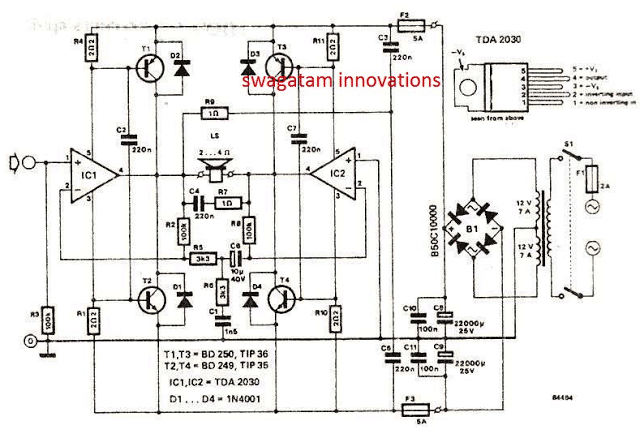A pair of TDA 2030 ICs may be cascaded in a bridged tied load (BTL) arrangement along with a few current boosting transistors to create an amazing 120 watt amplifier circuit.
Benefits of a BTL Amplifier Architecture
The primary goal of a BTL setup is to allow the load to operate in both directions, which contributes to a doubled rise in the system's performance level. It is comparable to the whole bridge network often seen in inverters.
The accompanying figure shows the whole circuit schematic for the suggested BTL 120 watt amplifier circuit that uses two TDA 2030 ICs.
Operation of Circuits
Both of the TDA2030 ICs, IC1 and IC2, have been configured in a bridged linked load arrangement. This implies that the loudspeaker is driven in a forceful push-pull mode by the two ICs acting in conjunction in accordance with the high and low amplitudes of the input frequency.
In this case, IC2 might concurrently supply a low output to the speakers while IC1's output could have been sending a high output, and the other way around, allowing the loudspeaker to perform the necessary push-pull motion. As a result, the loudspeaker would run at twice the efficiency level of typical amplifiers that are not BTL-based by switching between the maximum positive and negative supply levels.
Because the IC1 and IC2 alone cannot raise the amplifier's current level to the stipulated 120 watt RMS, the BJTs T1 through T4 are incorporated.
In addition to complementing the BTL architecture, the NPN/PNP output BJTs assist the ICs in achieving the desired power level on the loudspeakers.
The several resistors and capacitors placed surrounding the speaker have the ability to filter and attenuate the speaker's output, resulting in clear, distortion-free music.
Double Amplifier Power Supplies
A 12-0-12V/7 amp transformer provides the power for this 120 watt BTL amplifier that uses TDA2030 integrated circuits. Its output has been filtrated by means of the corresponding capacitors C8–C11 and rectified using a bridge rectifier.
The majority of BTL-based amplifier circuits demand a dual +/- 20V / 7 amp output, whatever the power supply generates.
